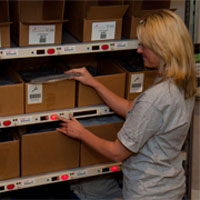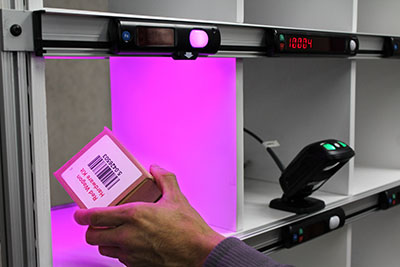Warehouse capacity improvement.
By Bob Betke
Vice President at F. Curtis Barry & Company
![]()
Although labor is the prime area of attention when it comes time to assess warehouse operations efficiency, another key area that can yield significant cost savings is the utilization of the facility itself. Probably the most frequent lament heard from our warehouse clients is the “I am running out of space in the warehouse”. Unless you are that rare company that has control over your forecasting and inventory management functions, you have probably said the same thing.
The first reaction from the warehouse is that you have too much inventory. Although it is easy to dismiss this as typical whining, there usually is some basis to the complaint. We recommend taking a close and structured look at the aging of your inventory while applying the true carrying costs of that aged segment to determine if it makes sense to consider some type of liquidation to reduce inventory levels. In addition, measuring the effectiveness of forecasts and inventory purchasing decisions as a “Post Mortem” analysis is always a good idea to make sure that there are no fundamental issues negatively affecting overall inventory levels. In most pick/pack type operation, finding the balance between backorder rates and inventory turns has always been and still is a major issue that drives inventory decisions. Having said that, let’s take a look at some ideas that might increase the storage capacity in your warehouse to accommodate required inventory levels.
There are the obvious issues of overall layout design and space utilization that affect the storage capacity along with the selection of appropriate storage media. After you achieve an effective layout, it is time to look for the fine tuning that can add to capacity. The following list represents several potential options or issues to consider.
- Rack over doors – Most receiving dock doors are spaced far enough apart to permit rack to be erected that spans the door openings. These racks can provide several levels of product storage above the clear height of the door opening. Many companies use this pallet rack storage for pallet or packaging material inventory storage.
- Tunnels in Rack – In warehouses where pallet rack is utilized, a missed opportunity exist if rack “tunnels” are not used over main or cross aisles. Most warehouses try to align rows of rack on either side of a main or cross aisle. The area above these aisles is wasted unless racking is installed that bridges the aisle between the ends of rows of rack. Even allowing clearance for lift truck traffic, it is possible to add two or three levels of pallet storage above these”tunnels”.
- One area to review is the width of existing aisles in the warehouse. Most material handling equipment is designed with a minimum aisle width or turning radius associated with that particular style. Make sure that you have not overdesigned the aisle width and waste potential storage space. In larger warehouses with many aisles of racking, a small decrease in each aisle width can add additional rack bays for storage. Make sure you don’t go too far in making them too narrow and causing other operational issues.
- Many rack layouts are designed to hide or bury building columns between rows of pallet rack. While this is always a good start, make sure the tradeoff of aisle width vs. lost storage capacity is evaluated. Sometimes it is better to lose a column of potential storage locations by locating the column within a rack pallet storage area and gain a net increase in overall storage locations through better aisle width management.
- After you establish the layout and location characteristics, the next job is to make sure you utilize all of the potential space in each location. We see instances where one or two cases are stored in a location designed for a full pallet. It is necessary to have a variety of location sizes to accommodate the variety of storage needs on a product by product basis. As the inventory level in a location changes, reevaluate whether it makes sense to relocate the inventory to a location that more closely matches the cubic storage requirement of the inventory. Another waste of space occurs in picking areas where only the front portion of the pick slot is utilized with empty space left behind. The slotting process should take care of this, but we see it a lot in many warehouses. Make sure the pick slot is designed to fit the cubic velocity of the SKU. It is impossible to attain 100% of capacity on a daily basis but the higher % you can maintain in established locations, the more space you will have available.
- Although they can be costly to install in some cases, the option of installing a mezzanine makes sense in some situations. If you can find the right use for this type space, you can double the footprint of the warehouse where you install the mezzanine. Issues such as beneficial use and the cost per square foot of space in your area will determine the potential use. Most mezzanines that are ineffectively used have not considered the material handling challenges presented by a multi level operation.
- One of the key ratios to consider in developing space saving ideas is the ratio of aisle space to storage space. One way to reduce the ratio is to block stack pallets of product on the floor and stack them two or three levels high. It requires enough inventory of the same SKU and product that can be stacked without damage. Floor stacking pallets four or five deep is not uncommon in operations with high stackable inventory per SKU. This ability to deep stack pallets with few aisles manages this space ratio to your advantage.
Theses are a few ideas to consider but by no means a complete list. The key is to consistently and objectively look for opportunities to better manage the four wall storage capacity with an open mind.
Bob Betke is a vice president at F. Curtis Barry & Company, a multichannel operations and fulfillment consulting firm with expertise in multichannel systems, warehouse, call center, inventory, and benchmarking. Learn more online athttps://www.fcbco.com or call 804-740-8743.












